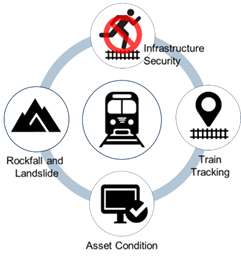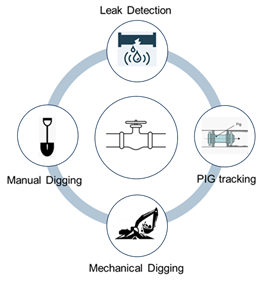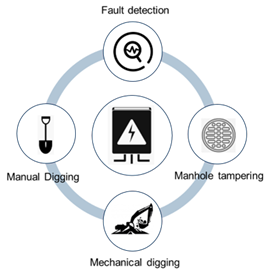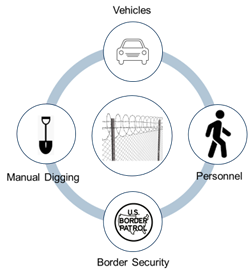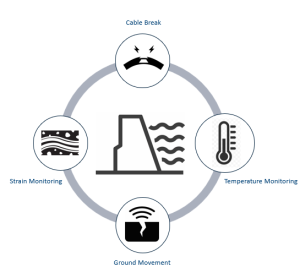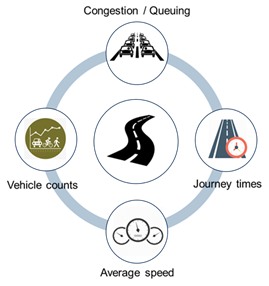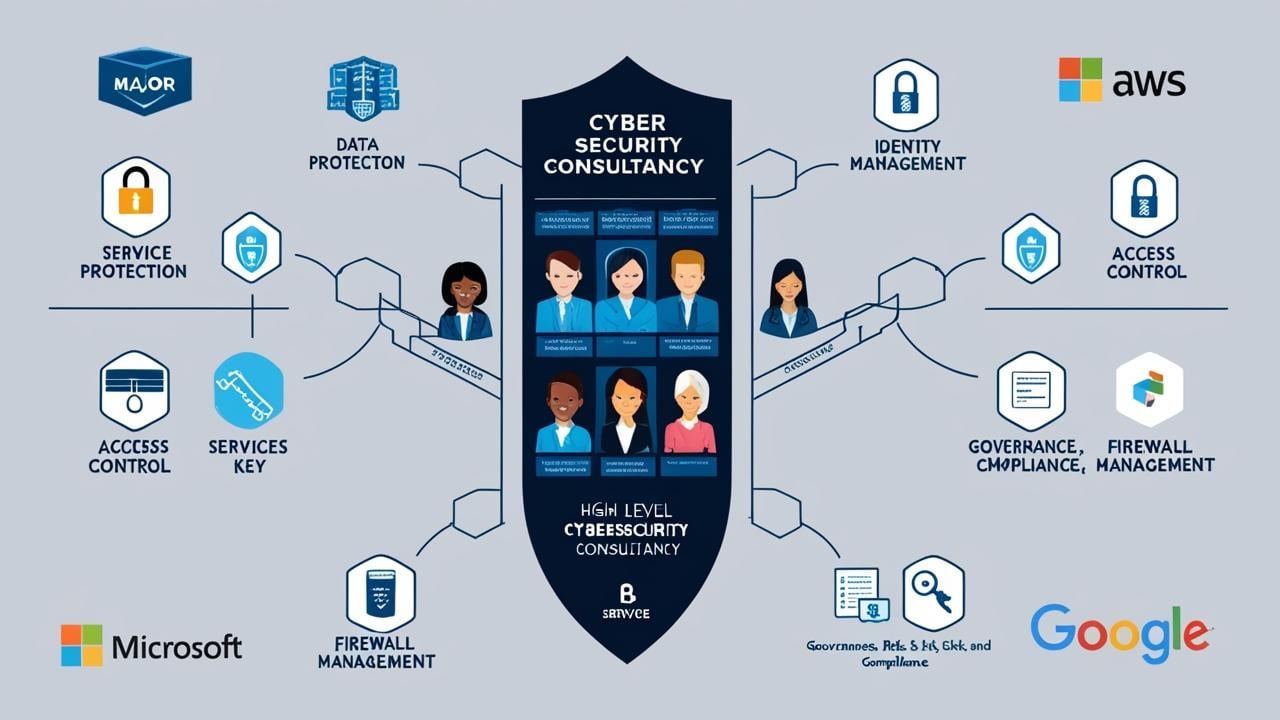Distributed Acoustic Sensing (DAS)
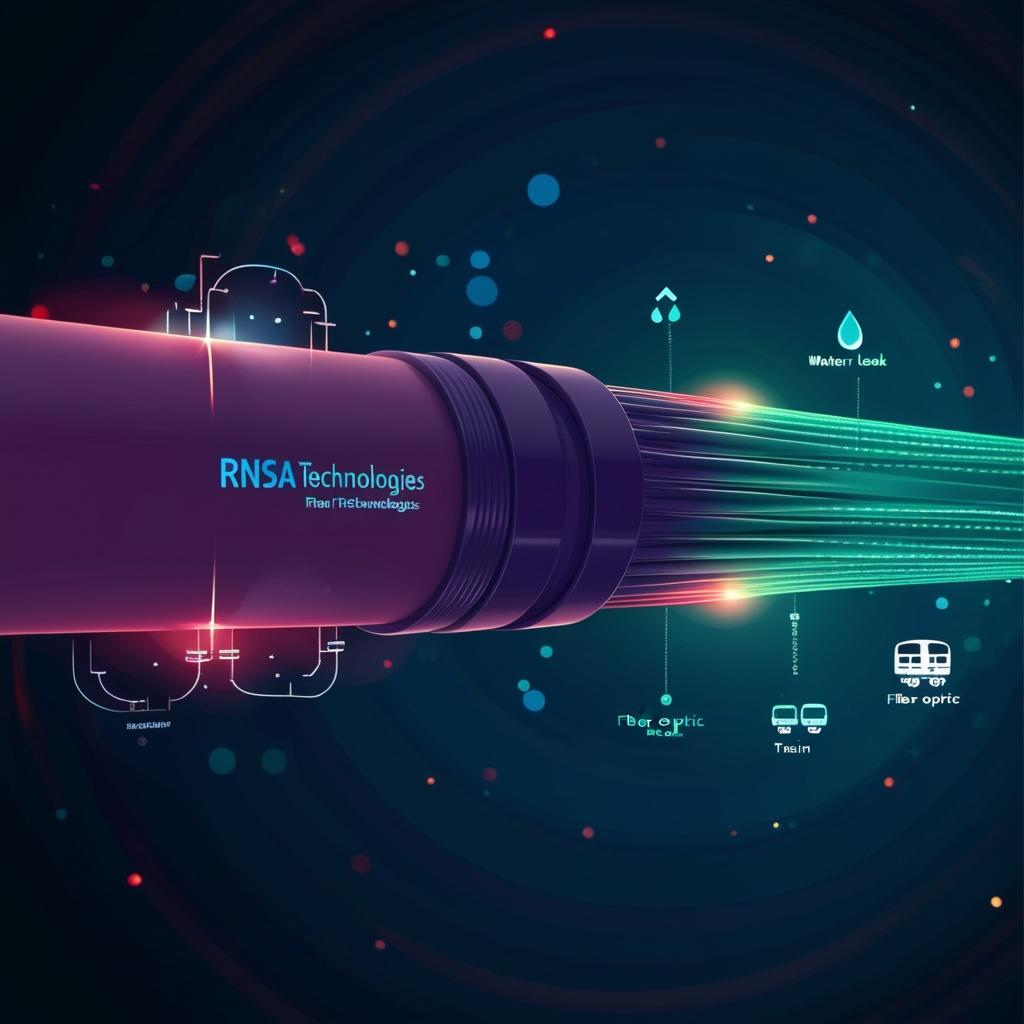
Distributed Acoustic Sensing, often referred to as DAS, is a technology that uses fiber optic cables to detect and measure acoustic signals. Here’s a simple breakdown of how it works:
- A laser is sent down a fiber optic cable. As it travels, it encounters tiny, natural imperfections in the cable.
- When these imperfections are disturbed by an acoustic or vibrational event, they cause a slight change in the laser light’s properties.
- The altered light is reflected back to the DAS unit, where it’s analyzed to determine the type, location, and intensity of the disturbance.
This technology is like having thousands of microphones along the length of the cable, each one able to detect and measure sound and vibrations. It’s used in a wide range of applications, from monitoring pipelines and power lines for leaks or faults, to detecting seismic activity, to enhancing security by detecting intruders or breaches in a perimeter.
RNSA’s Distributed Acoustic Sensing (DAS) : Rail Applications.
Distributed Acoustic Sensing (DAS) potential uses in Railway monitoring include:
- Track Monitoring: DAS could be used to monitor the condition of the tracks. By analyzing the acoustic signals, it could detect anomalies that might indicate wear and tear or damage to the tracks.
- Train Detection: DAS could be used to detect the presence of trains on the tracks. This could be particularly useful in remote areas where traditional detection methods might not be feasible.
- Maintenance Planning: By providing real-time data on track conditions, DAS could help railway companies plan maintenance activities more effectively. This could potentially lead to cost savings and improved safety.
- Security: DAS could be used to detect unauthorized access to the railway tracks. This could help prevent accidents and improve security.
- Environmental Monitoring: DAS could be used to monitor environmental conditions around the tracks. This could be particularly useful in areas where the railway passes through sensitive ecosystems.
- Disaster Prevention: In areas prone to natural disasters like landslides or earthquakes, DAS could provide early warning signals by detecting ground movement or vibrations.
Actual implementation would depend on a variety of factors including the specific needs of the railway company, the local environment, and the available infrastructure.
RNSA’s Distributed Acoustic Sensing (DAS) – Pipeline Applications.
Distributed Acoustic Sensing (DAS) potential uses in pipeline monitoring include:
- Leak Detection: DAS can be used to detect leaks in pipelines. The system can pick up the acoustic signals produced by a leak, allowing for early detection and prevention of major incidents.
- Third-party Interference: DAS can help identify activities near the pipeline that could potentially cause damage. This could include digging, construction work, or other forms of interference.
- Pipeline Integrity Monitoring: DAS can monitor the structural integrity of the pipeline. It can detect changes in the acoustic signals that may indicate a weakening or damage to the pipeline structure.
- Flow Monitoring: DAS can be used to monitor the flow of material within the pipeline. Changes in the acoustic signals can indicate changes in flow, which could be a sign of a blockage or other issue.
- Temperature Monitoring: Some DAS systems can also monitor temperature along the pipeline. This can be useful in detecting hotspots that may indicate a potential issue.
- Seismic Activity Monitoring: DAS can detect seismic activity that could potentially damage the pipeline. This can allow for early intervention and prevention of major incidents.
The actual application of DAS in pipeline monitoring may vary depending on the specific circumstances and requirements.
RNSA’s Distributed Acoustic Sensing (DAS) – Power and Mobile Operators Applications.
Potential applications of Distributed Acoustic Sensing (DAS) in power utility monitoring and mobile network providers include:
Power Utility Monitoring
- Fault Detection: DAS can be used to detect faults in power lines. The system can pick up the acoustic signals produced by a fault, allowing for early detection and prevention of major incidents.
- Third-party Interference: DAS can help identify activities near the power lines that could potentially cause damage. This could include tree branches touching the lines, construction work, or other forms of interference.
- Structural Monitoring: DAS can monitor the structural integrity of power lines and towers. It can detect changes in the acoustic signals that may indicate a weakening or damage to the structure.
- Temperature Monitoring: Some DAS systems can also monitor temperature along the power lines. This can be useful in detecting hotspots that may indicate a potential issue.
Mobile Network Providers
- Fiber Optic Cable Monitoring: DAS can be used to monitor the integrity of fiber optic cables used in mobile networks. It can detect physical stresses or damages to the cables.
- Network Traffic Monitoring: DAS can potentially be used to monitor network traffic. Changes in the acoustic signals can indicate changes in data flow, which could be a sign of a blockage or other issue.
- Third-party Interference: DAS can help identify activities near the network infrastructure that could potentially cause damage. This could include digging, construction work, or other forms of interference.
- Seismic Activity Monitoring: DAS can detect seismic activity that could potentially damage the network infrastructure. This can allow for early intervention and prevention of major incidents.
The actual application of DAS in power utility monitoring and mobile network providers may vary depending on the specific circumstances and requirements.
.
RNSA’s Distributed Acoustic Sensing (DAS) – Borders and Perimeters Applications.
Some potential applications of Distributed Acoustic Sensing (DAS) for border and perimeter intrusion detection include:
- Intrusion Detection: DAS can be used to detect any physical disturbance along a border or perimeter, such as footsteps or vehicle movement. The system can pick up the acoustic signals produced by these activities, allowing for real-time detection and response.
- Tunneling Activity: DAS can potentially detect tunneling activities. The acoustic signals produced by digging can be picked up by the system, providing an early warning of such attempts.
- Climbing Detection: If someone attempts to climb a fence or wall, the vibrations caused can be detected by DAS, alerting security personnel.
- Vehicle Tracking: DAS can also be used to track the movement of vehicles along a border or perimeter. This can be particularly useful in large, open areas where visual surveillance may be challenging.
- Seismic Activity Monitoring: DAS can detect seismic activity that could potentially damage the border infrastructure. This can allow for early intervention and prevention of major incidents.
- Wildlife Monitoring: In some cases, DAS can also be used to monitor wildlife activity along a border or perimeter. This can be useful in areas where wildlife movement is a concern.
The actual application of DAS on borders and other perimeters may vary depending on the specific circumstances and requirements.
RNSA’s Distributed Acoustic Sensing (DAS) – Seismic Activity and Mining Applications.
Distributed Acoustic Sensing (DAS) in seismic activity monitoring, including its use in mining operations include:
- Earthquake Detection: DAS can be used to detect the seismic waves produced by an earthquake. This can provide valuable data for understanding the earthquake’s source and magnitude, and can be particularly useful in mining areas where seismic activity could indicate potential safety risks.
- Monitoring of Mining-Induced Seismicity: Mining operations can often induce seismic activity. DAS can be used to monitor these events, providing real-time data that can help in managing and mitigating risks.
- Rockfall Detection: In mining operations, DAS can be used to detect the acoustic signals produced by rockfalls, a common hazard in mining environments. Early detection can help in evacuating personnel and preventing accidents.
- Structural Health Monitoring of Mines: DAS can be used to monitor the structural health of the mine itself. It can detect changes in the acoustic signals that may indicate a weakening or damage to the mine structure.
- Monitoring of Blasting Operations: DAS can be used to monitor the effects of blasting operations in mines. It can provide data on the seismic impact of the blast, helping to ensure that it is within safe and acceptable limits.
- Tunnel and Shaft Integrity Monitoring: DAS can be used to monitor the integrity of tunnels and shafts in mining operations. It can detect any changes in the acoustic signals that may indicate potential instability or damage.
- Structural Health Monitoring: DAS can be used to monitor the structural health of buildings and other infrastructure during and after seismic events. This can help identify any potential damage and guide repair and recovery efforts.
- Oil and Gas Exploration: In the oil and gas industry, DAS can be used to monitor seismic activity during exploration activities. This can help identify potential oil and gas reserves and guide drilling efforts.
The actual applications of DAS in seismic activity monitoring or in mining operations may vary depending on the specific circumstances and requirements.
RNSA’s Distributed Acoustic Sensing (DAS) – Traffic Monitoring Applications.
Some potential applications of Distributed Acoustic Sensing (DAS) in traffic monitoring include:
- Vehicle Detection: DAS can be used to detect the presence of vehicles on a road or highway. The system can pick up the acoustic signals produced by a vehicle, allowing for real-time traffic monitoring.
- Traffic Flow Monitoring: DAS can be used to monitor the flow of traffic. Changes in the acoustic signals can indicate changes in traffic flow, which could be a sign of a traffic jam or accident.
- Incident Detection: DAS can potentially detect incidents such as accidents or breakdowns. The acoustic signals produced by these events can be picked up by the system, providing an early warning to traffic management centers.
- Pedestrian Detection: DAS can also be used to detect the presence of pedestrians near or on the roadway. This can be particularly useful in areas where pedestrian safety is a concern.
- Vehicle Speed Monitoring: By analyzing the acoustic signals, DAS can potentially be used to estimate the speed of vehicles. This can be useful for enforcing speed limits and identifying areas where speeding is a problem.
- Infrastructure Health Monitoring: DAS can be used to monitor the structural health of roads and bridges. It can detect changes in the acoustic signals that may indicate a weakening or damage to the infrastructure.
The actual application of DAS in traffic monitoring may vary depending on the specific circumstances and requirements.
Cyber Security and Managed Security Services
RNSA Technologies, your trusted partner in comprehensive Cyber Security Consultancy. We specialize in a wide range of services, including Data Protection, Identity Management, Access Control, Governance, Risk and Compliance (GRC) and Firewall Management. Our expertise extends across leading cloud vendors such as Microsoft, AWS, and Google, as well as ERP security on platforms like Oracle and SAP. We understand the unique cyber security challenges faced by both government and private enterprises in South Africa, a region with high incidents and threat statistics.
At RNSA Technologies, we don’t just offer solutions, we offer peace of mind. We take into account both local and international regulatory frameworks to ensure our services not only protect your digital assets but also comply with all relevant laws and regulations. Our mission is to provide you with a secure digital environment, so you can focus on what you do best – running your business. Let us handle your cyber security needs, because at RNSA Technologies, your security is our priority. We are still your first line of Defence!

Our Managed Cyber Security Services refer to the outsourcing of monitoring and managing security devices and systems to a trusted third-party provider. These services can include intrusion detection, spam filtering, firewall management, security audits, threat intelligence, and more.
Integrating Managed Cyber Security Services into a Security Operations Center (SOC) and a Distributed Acoustic Sensing (DAS) response monitoring Network Operations Center (NOC) can have several advantages:
- Comprehensive Security: Combining these services can provide a more holistic approach to security, covering both digital and physical aspects. This can lead to a more robust and comprehensive security solution.
- Efficiency: Having a single point of contact for both cyber security and DAS response monitoring can streamline communication and response times, making the process more efficient.
- Cost-Effective: It can be more cost-effective to have these services managed under one roof, rather than outsourcing to multiple providers.
- Expertise: Managed Cyber Security Services providers have specialized knowledge and experience, which can enhance the quality of security monitoring and response.
- 24/7 Monitoring: Both SOCs and NOCs typically operate 24/7, providing round-the-clock monitoring and quick response to any security incidents or anomalies detected by the DAS system.
- Proactive Approach: Managed Cyber Security Services often include proactive threat hunting and prevention, which can complement the real-time monitoring provided by DAS and the NOC.
Remember, these are just ideas and the actual advantages of integrating Managed Cyber Security Services into a SOC and a DAS response monitoring NOC may vary depending on the specific circumstances and requirements.

